In 2022, Google updated its E-A-T guidelines to include an extra “E”—” Experience”.
But what does this mean for your SEO efforts?
In this guide, I’ll cover:
- What E-E-A-T actually is
- Its core elements
- The different levels of E-E-A-T according to Google’s Quality Rater Guidelines
- The best ways for you to improve your site’s E-E-A-T
My aim is to tell you everything you need to know about Google E-E-A-T and how to make it work for you.
Let’s go!
What Is E-E-A-T?
Before we talk about E-E-A-T we need to take a look at E-A-T.
E-A-T first made an appearance in Google’s Quality Rater Guidelines way back in 2014.
Google’s Quality Rater Guidelines are a set of instructions given to evaluators known as “Quality Raters”. These evaluators use the guidelines to assess the quality of Google’s search results.
The guidelines also help Google’s algorithm understand what constitutes good and relevant content.
The acronym E-A-T stands for expertise, authoritativeness, and trustworthiness. Google uses these criteria to assess the quality and credibility of content and sites.
So, what do expertise, authoritativeness, and trustworthiness mean?
Let’s break it down.
- Expertise: the level of skill and knowledge demonstrated by the content creator. Google expects content to come from individuals with genuine expertise in the topic they’re discussing.
- Authoritativeness: the authority and reputation of the content creators or the site itself. For a site or content creator to be considered authoritative, they need to be well-established and respected in their field.
- Trustworthiness: the credibility and reliability of the information presented. If content is accurate, well-sourced, and transparent then it’s more likely to be trusted by both users and search engines.
Simply put, E-A-T was designed to ensure that users are provided with reliable and valuable information when they use Google.
In December 2022, Google added an extra “E” to make the acronym E-E-A-T. This “E” stands for experience.
But what does this mean?
It means that Google now places more significance than ever on genuine, personal involvement or practical familiarity with the topic that’s covered in a piece of content.
The reason for this is that users are often looking for insights from people with actual experience of the topic they’re reading about.
This is particularly true when a user is considering whether to purchase a product or service or is looking for advice on a specialist topic.
For example, let’s say you want to learn how to perform advanced yoga poses safely. You’d most likely prefer to read content created by a certified yoga instructor.
Because of this, Google tends to reward pages with higher rankings where the content creator has actual experience with the topic they’re discussing.
If your content aligns with the E-E-A-T principles then its chances of gaining prominent positions in the SERPs are increased. It also makes it more likely that you’ll be able to successfully navigate future Google algorithm updates.
When Google introduced E-E-A-T, it also emphasized that the “T” (trust, just in case you forgot) is the foundation of E-E-A-T and holds HUGE significance.
Essentially, Google says that if your page lacks trustworthiness, then its level of E-E-A-T is greatly diminished.
This makes sense. Think about it—if users don’t trust your content then what value does it have, really?
The Core Elements Of E-E-A-T
Ok, so I’ve briefly covered what the different letters stand for in E-E-A-T.
Remember, Google considers trustworthiness to be the most important factor of them all. In fact, it uses experience, expertise, and authoritativeness to establish how trustworthy a site is.
Now, let’s take a deep dive into each of the four elements that make up E-E-A-T.
Experience
When Google refers to experience, it means real-world, first-hand involvement with the subject matter a piece of content is dealing with.
In the current digital landscape, where generative AI content is becoming commonplace, the value of experience is becoming more important.
This is one of the reasons that Google has added experience to its guidelines.
A true experience with a subject is (currently) outside the scope of AI capabilities. AI might attempt to emulate aspects of human experience but the content it produces doesn’t have genuine uniqueness.
Therefore, Google views experience as a key factor in distinguishing content created by humans from AI-generated content.
Because of this, Google places an emphasis on the authors of YMYL pages having a high level of experience and expertise.
YMYL pages cover topics that could potentially affect a person’s health, safety, happiness, or financial security if the information is inaccurate.
Here are some examples Google gives in its Quality Rater Guidelines to highlight this:

So, experience is very important to Google.
But how do you demonstrate this experience to Google when you’re creating content?
Let’s take a look.
How To Demonstrate Experience
There are several ways that you can demonstrate your experience to Google.
One of the most effective ways is to provide evidence of your experience in a particular subject.
Let’s say you run a site about carpentry tools.
Your audience ranges from novice carpenters to professionals who are all looking to improve their skills.
To demonstrate that you have actual experience within your field, you create videos where you show your audience how to use various carpentry techniques.
Just like this site, for instance:

Clearly, the content creator here has hands-on experience with these tools and users can actually see this for themselves.
Google’s Quality Raters would also view this as a good demonstration of experience which means they’re more likely to view the site as trustworthy.
Expertise
The way Google interprets expertise is closely linked to the creator of the content.
Google’s Quality Raters consider how much dedication, labor, and proficiency have been invested in creating a specific piece of content.
They ask questions like:
- Who is the driving force behind the content?
- Is the creator well-versed in the subject matter?
- What is the creator’s standing within the field?
As with experience, the importance of expertise depends on the type of content.
For YMYL topics like finance and medicine, demonstrating expertise is VERY important. In these cases, the author is expected to provide information that is within the current medical or financial consensus.
The author’s qualifications, academic achievements, and standing within their field are also crucial when creating such content.
However, for certain topics and content types, everyday proficiency can also be classed as expertise.
To make this clearer, let’s look at some examples:
Example 1: You’re looking for articles about the art of making a classic Italian pasta dish.
You find an article written by a renowned culinary expert who has spent their life studying Italian cuisine. They’ve worked in Michelin-starred restaurants and they’ve even written a book about Italian cooking.
The article talks extensively about the history of the pasta dish, and the cultural significance of the ingredients, and gives you insights into traditional techniques.
Example 2: Another article you find is written by a passionate home cook who has spent years perfecting their own version of the dish.
They don’t have any formal culinary training, but they have experimented with many techniques, ingredients, and flavors over the years.
The content is engaging and relatable, and the author gives you some personal anecdotes about cooking this dish for their family.
In this context, and in the first example, the article demonstrates a deep level of expertise and authoritative knowledge. This article will be suited to users looking for a deep understanding of the history of the dish and its cultural context.
The second example demonstrates a type of expertise based on practical experience and experimentation. The article may resonate more with home cooks looking for practical and relatable advice.
Google’s Quality Raters would likely appreciate the expertise on show in both articles and would take the context into account.
Of course, this would be different if the articles were dealing with YMYL topics.
For instance, if you were looking for an article about health and safety regulations you’d be more interested in a qualified expert than an enthusiast.
How To Demonstrate Expertise
One of the most straightforward ways to demonstrate your expertise to Google’s Quality Raters is to add information about yourself or the other content creators for your site.
You should consider including details about the author like their qualifications, career information, and status within a specific field.
If someone is looking for medical advice then clearly an author with a medical degree will be viewed as an expert source.
Take a look at this article from Healthline. First of all, we’re shown that the article has been reviewed by a medical expert.

By listing this person’s qualifications, we get a clear indication of their expertise in the field.
Plus, at the bottom of the page, we get a lot of info about the author.
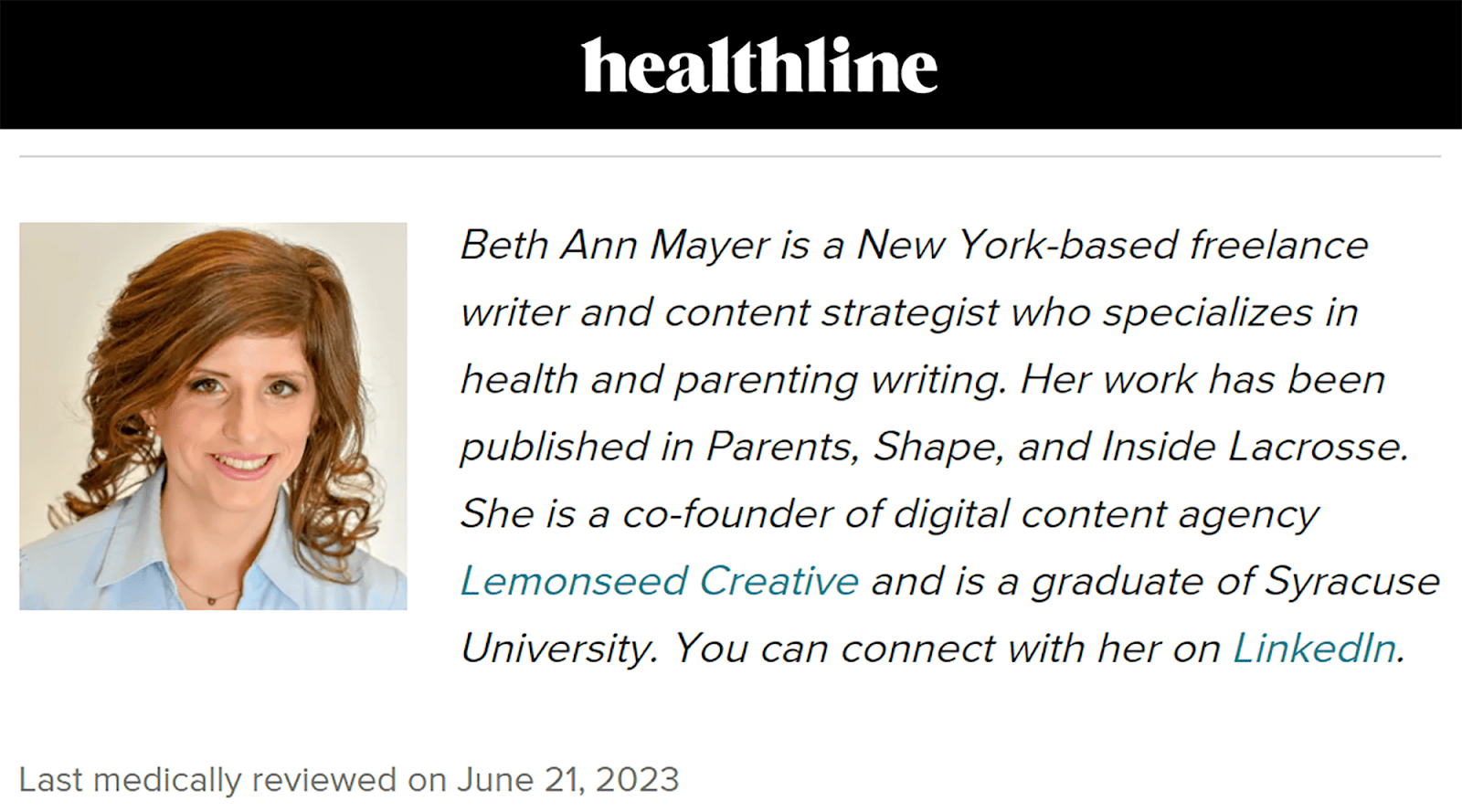
You can also add sources to your content to show that your views are backed up by expert consensus. This is particularly important for YMYL pages. You need to be able to demonstrate that your content is well-researched and up-to-date with the latest developments.
Earlier, I also mentioned how everyday proficiency can be interpreted as expertise too.
So what’s a good way of demonstrating this type of expertise to Google?
Well, it may sound very simple but make sure you write about subjects you know.
For example, if you spend lots of your time working on car engines then you should have some expertise on them. You should be able to create a blog that’s full of useful content about common issues with engines and so on.
On the other hand, if you’ve never baked a cake in your life and you start a cake-baking blog, it’ll quickly become apparent to users and Google that you don’t have any expertise in this field.
Authoritativeness
This refers to how much authority a content creator or a site holds.
Essentially, it means to what extent you’re a go-to source for knowledge on a subject.
For example, the Financial Times is considered to be one of the most authoritative sources in the world when it comes to the topic of finance.
Likewise, ESPN carries huge authority within the field of sports.
But why is this the case?
Browse any of the articles on sites like these and the first thing you’ll notice is a massive amount of (you guessed it) experience and expertise on show.
You’ll also notice that these sites have:
- Backlinks from other authoritative sites
- Authors with strong personal brands or digital profiles as experts in specific topics
- Strong content architecture that covers all aspects of a certain topic
When considering authoritativeness, bear in mind that it always goes hand-in-hand with expertise and experience.
If you don’t have any expertise or experience around a topic then you can’t be a voice of authority on it.
How To Demonstrate Authoritativeness
As mentioned, one way of building the authoritativeness of your site is to earn backlinks from other high-authority sites.
But how do you go about this?
One of the best ways to do it is by using Semrush’s Backlink Gap tool to view high-authority sites that are linking to your competitors’ pages but not yours.
To use the Backlink Gap tool, type your domain in first and then your competitor’s domain. Next, click “Find prospects”.

You’ll then be shown a list of referring domains that are linking to your competitor’s pages. However, we’re only looking for domains with high authority. So, to view these, you need to use the “Authority Score” filter. Click on the “Authority Score” dropdown box and type in a custom range from 50 to 100, and click “Apply”.

Here, you’ll only see referring domains with an authority score that’s within this range. You can then go through the list and click on the number in the column under your competitor’s domain. When you do, you’ll be able to see which page has been linked to under “Anchor and Target URL”.

Now, if you have a page on your site that’s covering the same topic, compare it against your competitor’s page. You’ll need to identify gaps in their content that you can capitalize on, and find ways to enhance your own content so that it’s superior to that of your competitor’s.
If you don’t have a page that’s covering the topic then you’ll need to create content around that topic ASAP.
Next, you’ll need to reach out to the referring domain that is linking to your competitor’s page and try to acquire the link for your page. When you’ve decided which referring domains you want to target, select the boxes next to them and click “Start Outreach”.

Now, you’ll see the list of the referring domains you’ve selected to target. Next, choose which project you want to save them to, and click “Send Prospects”. These referring domains will then be saved in the Link Building tool where you can access them at any time.

Building links with sites within your niche is a great way of establishing authority for your website.
For example, if a blog post about basketball earns itself a link from a site like ESPN, this helps to build the reputation and authority of the site.
Users trust ESPN as a voice of authority within the sports niche and when they follow a link that leads to your page, you are seen as a credible and reputable source which enhances your authority.
You should aim to build topical authority on your site too.
This means creating high-quality content that deals with all aspects of your topic.
Think about it like this:
You’re looking to hire a fitness trainer to help you achieve your health goals. The first trainer you meet has knowledge of basic fitness routines. The second has knowledge of basic fitness routines as well as advanced training techniques, injury prevention strategies, and meal planning.
The third trainer has all of the same knowledge as the previous two. However, they can also demonstrate their expertise through real-life success stories of clients they helped to transform their fitness.
Clearly, you’re going to view the third trainer as the most authoritative option.
The same applies to your site.
You should have a content strategy that helps you to demonstrate your topical authority on your subject. So how do you do this? Well, you need to create as much helpful content as possible that covers all aspects of your topic.
For instance, if you only publish one article about cycling on your site, Google won’t view you as an authority within the cycling niche. However, if you post a large number of articles covering all aspects of cycling (safety gear, training routines, bike repair tutorials, etc.). Google will start to view you as an expert and authoritative source.
Your content should be truly helpful and it should aim to answer everything a user wants to know about the topic.
So, how do you go about this? Well, first, you need to do some keyword research to generate some content creation ideas. One of my favorite tools for keyword research is Semrush’s Keyword Magic tool.
Here’s how to use it. Head over to the Keyword Magic tool.
Next, type in your seed keyword, for example, “cycling”, and hit “Search”.

You’ll then get a list of keywords related to your seed keyword, along with their monthly search volume and keyword difficulty scores.

On the left, there are different groups of keywords. These are subtopics related to your seed keyword.

If you click on one of these subtopics, such as shoes, you’ll get a list of keywords related to your seed keyword and the subtopic. For example, “indoor cycling shoes”.

Now, you’ll have a significantly larger number of keywords to choose from to create content around.
To save your keywords, simply check the boxes next to them and click “Add to keyword list”.

You can then view them whenever you want in the Keyword Manager tool.
Another great way to find ideas for your content is to use Semrush’s Topic Research tool. All you need to do is type a topic into the search bar and click “Get content ideas”. Here, I went with “gardening”.

The tool will then generate different cards with related subtopics and other ideas that are relevant to your main topic.

If you click on one of the cards, you can see the search volume, difficulty, and topic efficiency. Plus, you get headings that are being used for the subtopic and questions users are asking about it.
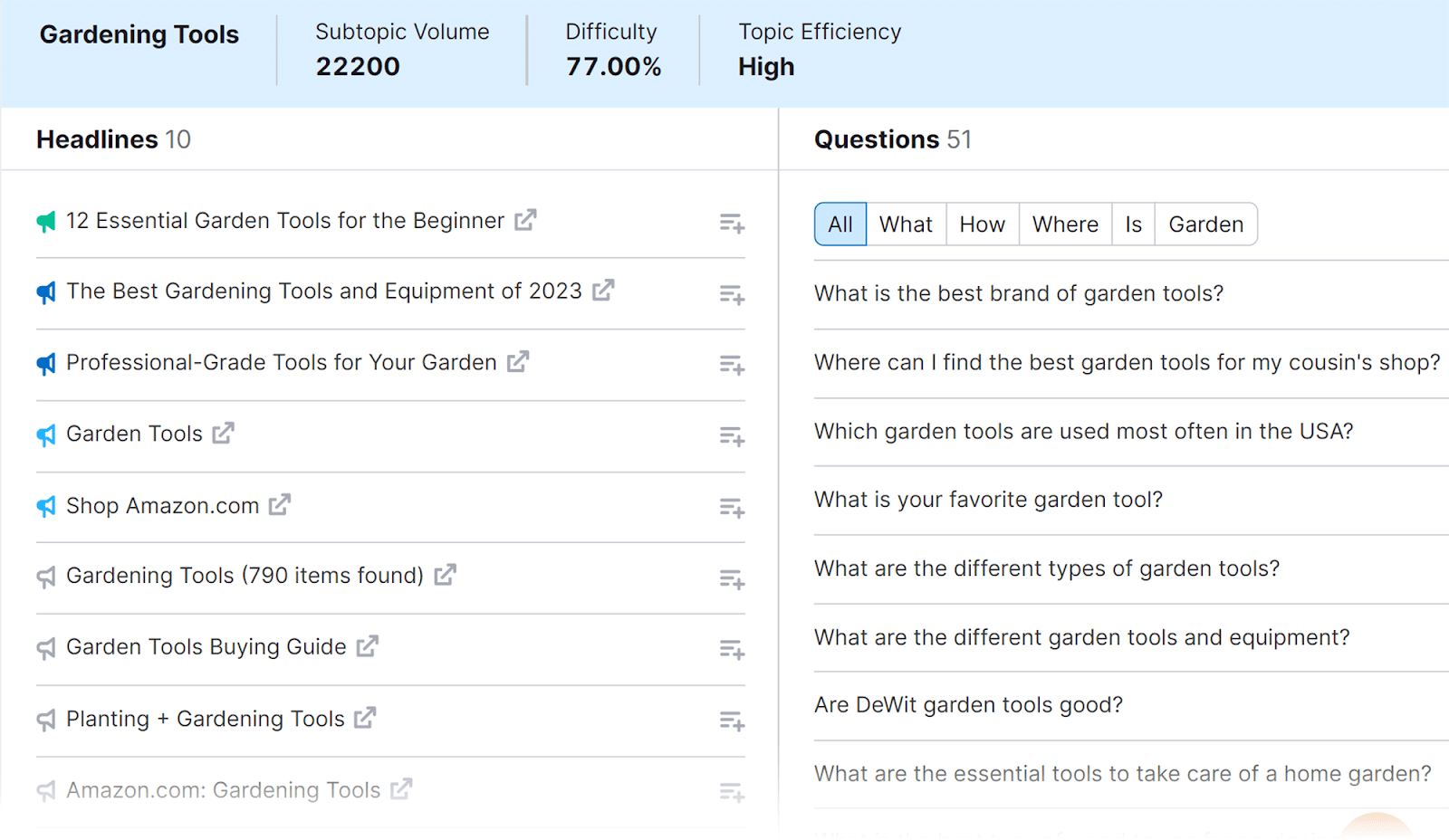
This gives you loads of ideas that you can use to create your own content and start building your site’s authoritativeness.
Another way of building the authority of your site is to pay close attention to Stanford’s Web Credibility Guidelines which state that you should:
- Make it easy to contact you.
- Make it easy to verify the accuracy of the information on your site.
- Design your site so it looks professional (or is appropriate for your purpose).
- Make your site easy to use – and useful.
- Update your site’s content often (at least show it’s been reviewed recently).
- Use restraint with any promotional content (e.g., ads, offers).
- Avoid errors of all types, no matter how small they seem.
Trustworthiness
As I said earlier, trustworthiness is the most important factor in Google’s E-E-A-T.
Essentially, Google considers your site to be trustworthy if it demonstrates experience, expertise, and authoritativeness.
If you think of E-E-A-T as four pillars, trustworthiness would be the horizontal one at the top and E-E-A would be the other three supporting it.
A page can seem to demonstrate experience, expertise, and authoritativeness but still be regarded as untrustworthy by Google’s Quality Raters.
So, if users lack trust in your page then all of your other SEO efforts have pretty much gone to waste.
Still, how important trustworthiness is to a page or site depends on the type of content. Google considers the intended purpose of the content when it evaluates its trustworthiness.
For instance, a YMYL page that provides crucial information needs to be more trustworthy than a blog post giving an opinion about the best taco spots in LA.
Let’s say you advise US citizens that they don’t need to get a visa before they travel to Japan. Well, it turns out they do. If this advice was posted on your site, guess what? Both users and Google’s Quality Raters are going to view your site as pretty darn untrustworthy.
Let’s look at another example.
If you run an e-commerce site, then users need to be able to trust that any online financial transactions will be handled correctly.
If your site doesn’t use SSL (Secure Socket Layer) encryption or HTTPS (Hypertext Transfer Protocol Secure) then users are unlikely to trust you.
A quick and easy way of checking your site’s security is by using Semrush’s Site Audit tool.
First, click on “Site Audit”, enter your domain into the search bar, and click “Start Audit”.

You’ll then be taken to the “Site Audit Settings” menu. If you’re happy to use the default settings then just click “Start Site Audit”.

Or, if you want to customize the settings you can use the six tabs which are:
- “Domain and limit of pages”
- “Crawler settings”
- “Allow/disallow URLs”
- “Remove URL parameters”
- “Bypass website restrictions”
- “Schedule”

Once the audit is complete, click on your project.

On the next page, under “Thematic Reports” you’ll see the “HTTPS” widget. Click “View details”.

The tool then tells you:
- Your “HTTPS” Implementation score
- If your security certificates are up to date
- If your server security is up to date
- How secure your site architecture is

If the audit detects any issues with the security of your site, you can click on the issue and Semrush will give you advice on how to fix it.

How To Demonstrate Trustworthiness
As long as your site has an honest intent, it’s not actually too difficult to build trust. Remember, the best way to do this is to demonstrate experience, expertise, and authoritativeness.
There are other ways to build trust in your site though, including:
- Precise Contact Information: Depending on the type of site you run, providing clear contact details is a good way of establishing trust. This is particularly important for e-commerce sites.You should have a contact page that lists a name, address, phone number, and email address. You should also include a privacy and cookie policy. If your site sells goods, then you’ll need a returns policy too. This will usually be located in the footer menu along with your site’s copyright stamp.
- Customer Support: As well as providing basic contact information, you should also provide detailed customer service details. Tell users what the expected response times are, make them aware of the available support channels, and inform them of any additional assistance that’s available.
- Avoid Click-Bait Tactics: Stay transparent and don’t use click-bait headlines. Your content should be accurately represented in your meta titles, meta descriptions, and page titles.
- Keep Your Content Updated: Your content should be regularly updated. If your site is full of outdated content then Google isn’t going to place much trust in it.
- Allow Genuine Testimonials and Reviews: Enable users to leave reviews and testimonials. Good feedback builds trust and dealing with negative feedback demonstrates accountability.
- Secure Financial Transactions: If your site processes payments or other sensitive data you need to safeguard your users. You should employ secure HTTPS connections and have valid SSL certificates. You should also display verified security seals from well-known providers, like this:

Levels of E-E-A-T and Google’s Search Quality Rater Guidelines
Google’s Search Quality Rater Guidelines show that E-E-A-T has different levels: “Lowest”, “Lacking”, “High Level”, and “Very High Level”.
The SEO objective is to elevate your pages’ E-E-A-T to the highest level possible.
If your site and content are genuinely beneficial to users then it’s unlikely to have a notably low E-E-A-T level.
Sites on the lowest E-E-A-T level are generally spammy and have next to no credibility. If you want your site to reach higher E-E-A-T levels then it takes effort, and care.
You need to create a content strategy that’s focused on sharing valuable content that caters to users at each stage of their journey.
If you do this, then you’ll be on the right path. Still, it’s helpful to understand the different levels of E-E-A-T as laid out in the guidelines.
So, let’s have a look.
Lowest E-E-A-T
Pages in this category are often spammy and lack credibility. They fail to provide a positive user experience (UX).
These are the types of pages considered to have the lowest E-E-A-T according to Google’s Search Quality Rater Guidelines:
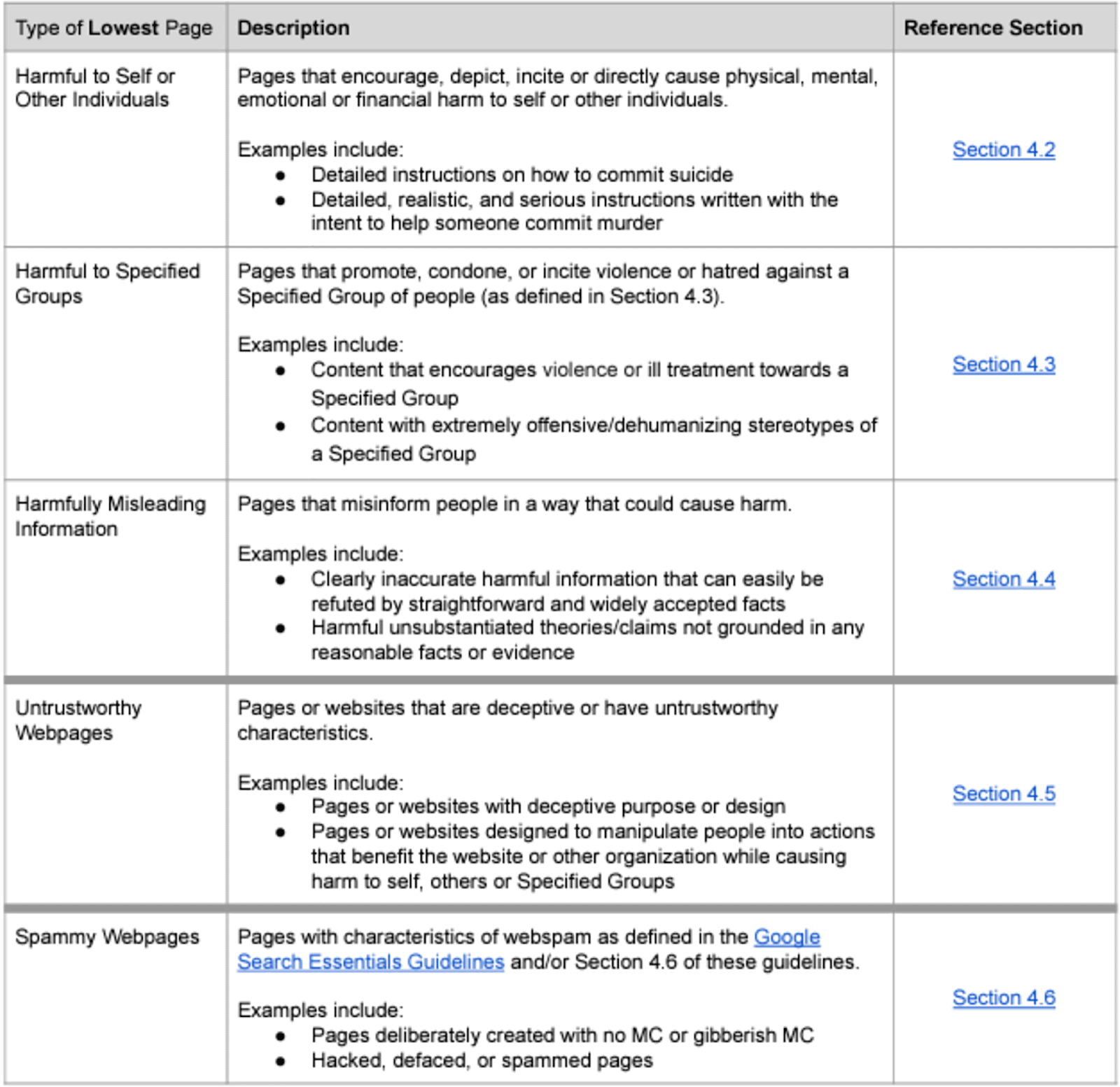
Note: When Google refers to “MC” this stands for “Main Content”.
So, the lowest E-E-A-T pages demonstrate a wide range of harmful, spammy, or deceptive practices.
It’s vital you understand what causes pages to have the lowest E-E-A-T levels. Avoiding these practices can help you maintain a positive online presence and uphold ethical standards in your digital interactions.
Lacking E-E-A-T
In Google’s Quality Rater Guidelines, it’s made clear that a specific page can be lacking E-E-A-T even if the rest of the site is reputable.
For example, let’s say you run a health and fitness blog.
The majority of the blog posts on your site deal with topics like supplements and workout guides.
They contain relevant and expert knowledge written by experienced fitness fanatics, and your site is generally a trusted source within your niche. However, one of your blogs is a listicle about expensive guitars.
It doesn’t matter to Google that your other blog posts are top-notch. As the topical relevance is low for that page it would be classed as lacking E-E-A-T.
As Google states in its guidelines:
“The Low rating should be used if the page lacks appropriate E-E-A-T for its purpose. No other considerations such as positive reputation or the type of website can overcome a lack of E-E-A-T for the topic or purpose of the page.”
Google also lays out other examples of the types of pages it considers to be lacking E-E-A-T:

Unlike pages with the lowest levels of E-E-A-T, pages lacking E-E-A-T aren’t considered to be harmful or to have the potential to cause harm.
They are more a result of carelessness and a lack of quality and relevance.
Google guides its raters to look out for:
- Poor quality MC that hasn’t been created with adequate originality, talent, effort, or skill needed to satisfyingly achieve the purpose of the page.
- Slightly exaggerated, shocking, or misleading titles
- Sites or content creators with mildly negative reputations
- Unsatisfying amounts of information about the content creator or site that’s necessary for the page
- Ads or supplementary content that distract from the main MC of the page significantly
Let’s take a look at an example of a page that meets at least one of these criteria.
This article is titled “40th Birthday Party Food Ideas”.
At the top of the page, you have some of the MC.

As you can see, it’s poorly written and there are errors. This clearly shows a lack of effort and skill. But it gets WAY worse.
When you scroll down, you’re met with several ads.

Now, I think it’s fair to say that Google’s raters would class those ads as distracting from the MC significantly.
So, even if the rest of this site is fairly reputable, this page is almost certain to get a low E-E-A-T rating.
High E-E-A-T
Pages with a high level of E-E-A-T offer significant amounts of expertise, credibility, and trustworthiness.
In the last section, I mentioned that a generally credible site can have a page that’s classed as lacking E-E-A-T.
Well, the same applies here.
A site could lack credibility on most of its pages but still have one or two that are classed as having high E-E-A-T.
In Google’s Quality Rater Guidelines, it lays out the characteristics of pages with high E-E-A-T:
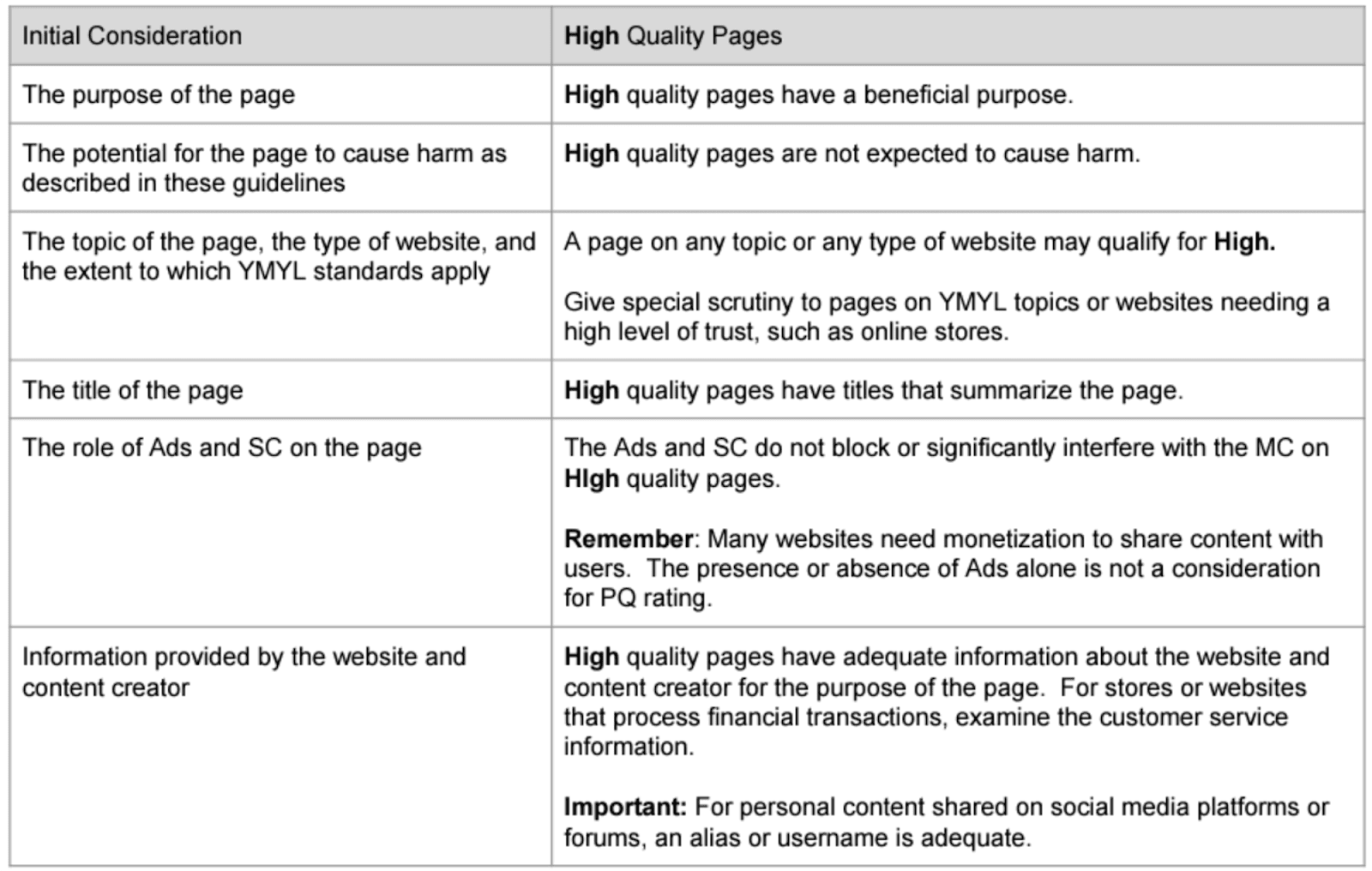
Here’s an example from the Quality Rater Guidelines of a page with high E-E-A-T. Google considers this content to have fulfilled the stated purpose of the page.

Very High E-E-A-T
Pages with very high E-E-A-T are produced by content creators who are unparalleled, credible authorities on a topic.
They demonstrate extensive hands-on knowledge of the subject they’re writing about and are considered to be VERY reliable sources of information.
This leads to a high E-E-A-T rating, particularly when the topic requires the content creator to have a lot of experience and expertise.
For example, if you read a news article about a serious financial issue, you’d expect the author to be an expert in finance and to have hands-on experience within this field.
Take a look at this finance article from CNBC. The author is clearly listed.
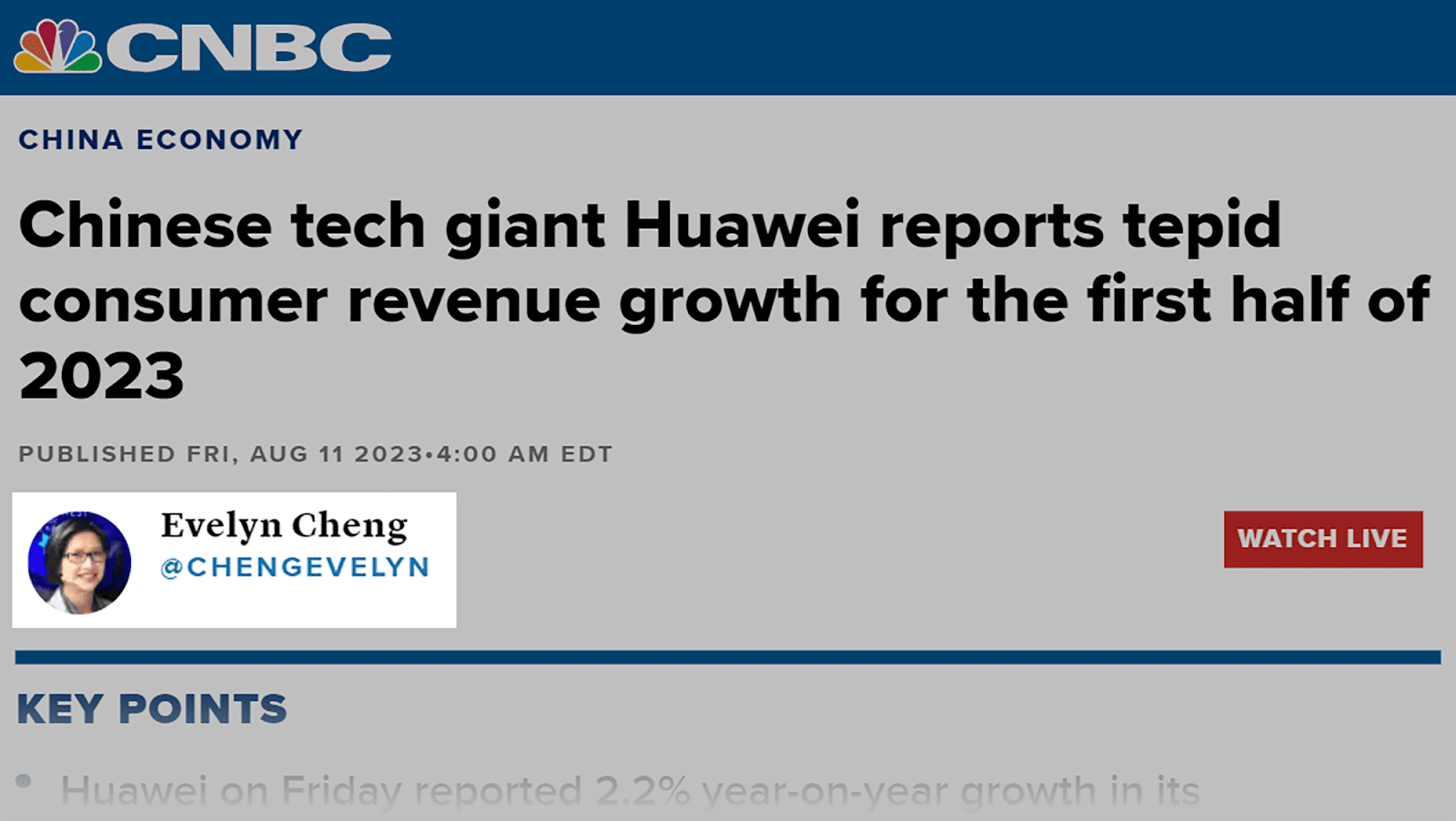
If you click on their name, you’re taken to a page with info about them.

The info provided clearly shows the author’s experience, expertise, and authority which builds trust in the article’s content.
However, if you read a listicle of someone’s favorite books you wouldn’t necessarily expect them to have a high level of expertise or experience in the world of publishing.
So, how does Google determine the experience and expertise of an author?
Well, it looks at numerous factors including:
- The author’s level of training and education
- How much content the author has published
- The amount of time an author has been publishing content about a specific subject
- How long it has been since the author last published something
- How relevant the author’s occupation is to the content they publish
Still, the reputation of the author isn’t enough to get a page a very high E-E-A-T rating. The page also needs to have a “very satisfying MC that achieves the purpose of the page well.”
Is E-E-A-T A Ranking Factor?
Not exactly. E-E-A-T isn’t a single metric that can be measured by SEOs and Google. This means that E-E-A-T isn’t used as a direct ranking factor by Google. However, a site’s E-E-A-T signals DO contribute towards other ranking factors.
You should think of E-E-A-T as a concept rather than a ranking factor. But, it’s a concept you need to incorporate into every piece of content you create. Google views E-E-A-T as a crucial factor in how valuable your pages will be to users.
In regards to E-E-A-T ratings, in “How Google fights misinformation” Google states that:
“The resulting ratings do not affect the ranking of any individual website, but they do help us benchmark the quality of our results, which in turn allows us to build algorithms that globally recognize results that meet high-quality criteria.”
So, even if it’s not a direct ranking factor, E-E-A-T is VERY important.
How To Improve Your E-E-A-T
I’ve already covered how to demonstrate E-E-A-T to Google’s Quality Raters. But how do you go about improving your E-E-A-T if it’s not in great shape?
Luckily, there are plenty of ways to do this.
Semantic Content Linking
Use internal links to build meaningful connections with relevant content on your site. This helps you to build interconnected topic clusters which will showcase your expertise within the specific topics you cover, and demonstrate a depth of knowledge to Google.
For example, if you have a blog post about luxury hotels in Tahiti, it makes sense to include an internal link to any other posts that cover Tahiti as a topic.
Your internal links should be embedded in rich anchor text that clearly describes the content that’s being linked to. To ensure this is happening across your site, you need to check if there are any links embedded in non-descriptive anchor text. This is when the anchor text doesn’t match the context of the link. For example, linking to a page about healthy cereals using the anchor text “optimal”.
To help you identify any instances of non-descriptive anchor text on your pages, you can use Semrush’s Site Audit tool. Head over to “Site Audit” and choose your project. Then, click the “Issues” tab.

Next, you need to scroll down to the “Notices” section and see if the tool has identified any links embedded in non-descriptive anchor text. Here, it’s telling me there is one example of this on my site.
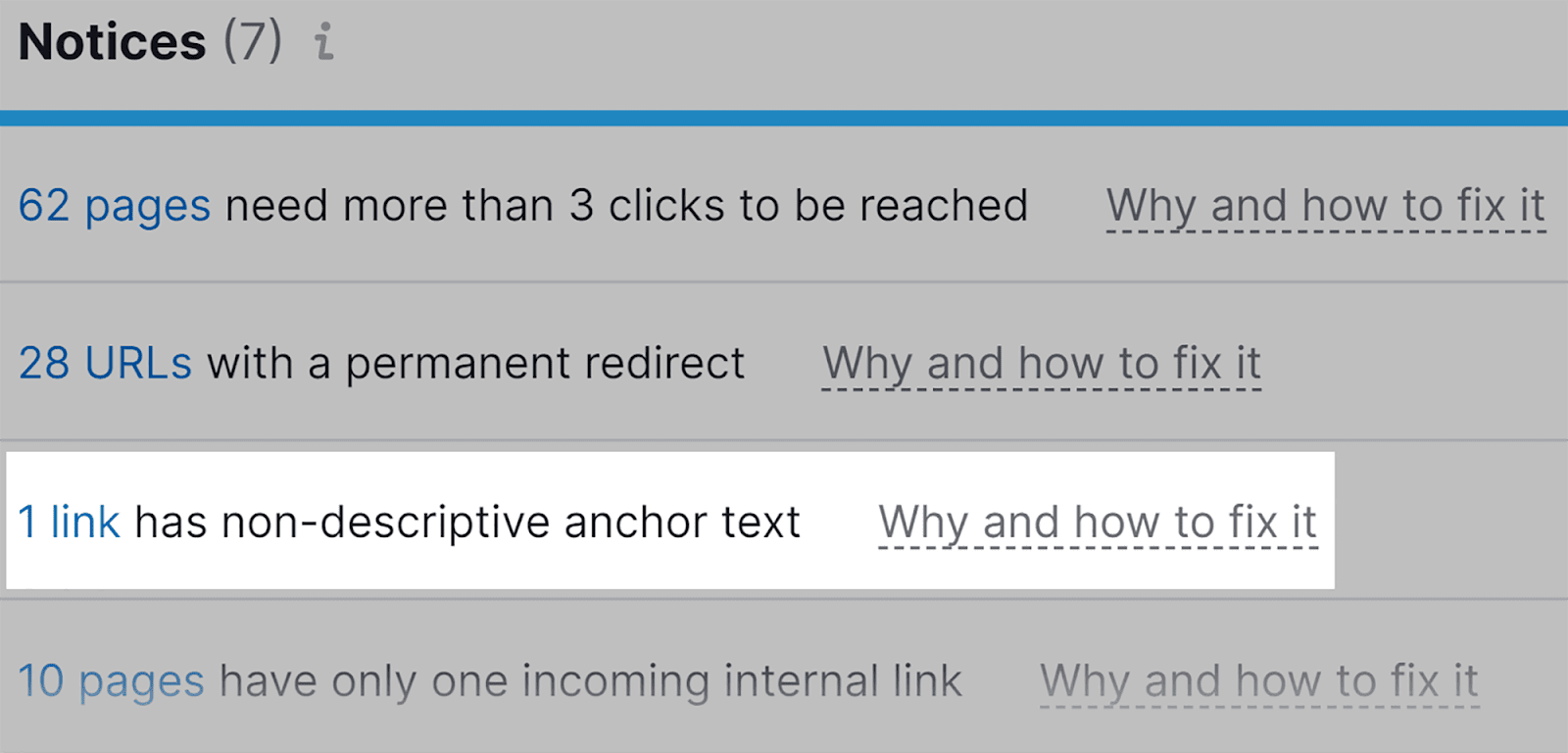
When I click on the issue, I can see the anchor text that needs to be addressed and the page it appears on.

If you find this issue on your pages then you should look into replacing these with descriptive anchor texts that provide context to the reader and search engines.
Collaborate With Experts
You should look to collaborate with recognized experts in your niche. This could mean co-authoring content, reviewing products together, or even co-hosting webinars about your specialist topic.
For experts to be “recognized” by Google, it means they’ve demonstrated strong E-E-A-T signals through things like their:
- Sites or blogs
- Social media profiles
- Online publications
- University site profiles
- Amazon author profiles
You should also reference experts in your content through external links. This is especially important for YMYL content.
Address Knowledge Gaps
The majority of content online is simply people re-hashing the same content over and over again.
We’ve all had the experience of researching a topic and realizing that the top results in the SERPs are giving the exact same information as each other. A great way of demonstrating E-E-A-T to Google is to fill a knowledge gap by bringing something new to the table.
This could be an interesting fact that you haven’t seen in any of the other top-ranking results on Google. Or, it could be a unique perspective on a subject that’s been covered many times.
If you think about it, what do experts do? They tell you things about a topic that you didn’t know before.
One of my favorite ways of finding knowledge gaps is by using Semrush’s Topic Research tool. To start, type in your topic.

On the next page, add a competitor’s domain and click “Get Content Ideas”.

The tool will then present various cards with subtopics relating to your main topic. The green ones with a tick on them are subtopics that your competitor is ranking in the top 100 Google results for. The others are subtopics that your competitor hasn’t covered yet.

You’ll now know which subtopics your competitors have missed and you can start creating content that fills this gap. This is a brilliant way of demonstrating your expertise to Google.
Mix Up Your Content Types
Your content doesn’t have to just be text. You should get creative and include different types of content on your site.
Consider adding content like:
- Podcasts
- Videos
- Webinars
Videos are particularly important if you write product reviews. When a user can actually see you using a product and giving your opinion about it, it demonstrates experience and helps to establish trust.
Use Person Schema Markup
Person schema markup is a type of structured data. By implementing this type of structured data on your page, you enable search engines to better understand the relationships between authors and their content.
When Google comprehends this authorship information, it can potentially display enriched search results such as knowledge panels with concise and relevant info about specific authors.
Person schema markup is particularly useful for your “About Us” page. You can include photos, names, roles, qualifications, and any other relevant info about the members of your team.
Here’s an example of Steve Jobs’ knowledge panel on Google:

Keep Your Content Fresh
You should regularly add new content to your site to show Google that your site is well maintained. It also demonstrates E-E-A-T as it shows you constantly have new knowledge to provide about a topic.
How regularly you need to add new content depends on the type of content you create. If you’re known for long-form articles based on heavy, scientific research then it makes sense that you’re not adding content every day.
On the other hand, if you mostly post short opinion pieces about new movies then you’ll need to post content more regularly.
Remember, you should also be updating your content pretty frequently as well. This doesn’t just mean changing the title of a piece from “Best Vacation Spots For 2022” to “Best Vacation Spots For 2023”. Google probably isn’t going to fall for that trick.
The content itself needs to be updated to reflect changes and new information that’s surfaced since you wrote the original piece.
Stay On Top Of Your Technical SEO
Your site’s functionality is also factored into E-E-A-T.
If your site doesn’t function properly and provides a poor user experience, then there’s little chance of your site visitors trusting you. It also doesn’t exactly give off an air of expertise if your pages take ages to load and your site structure is bewildering.
To stay ahead of any issues that could impact your site’s performance, make it a habit to conduct regular technical SEO audits. To help you do this, you can use Semrush’s Site Audit tool.
Here’s how to use it.
Head over to Site Audit, select your project, and click on the “Issues” tab. The tool will then present you with a list of issues it identified. These could include technical SEO problems like 404 errors, AMP-related issues, and so on.

Next to each issue, you can click “Why and how to fix it”. This gives you more info about the issue and tells you how to address it.

Establish A Positive Brand Reputation
If your brand has a positive reputation then it helps to enhance the trustworthiness of your site. On the flip side, if you have a negative brand reputation users are likely to think you lack credibility.
One of the best ways to build a positive reputation is to respond to reviews—good and bad. If you spot a negative review of your brand then respond in a helpful and transparent way. Apologize for what’s happened and offer advice or info that could help to resolve the issue.
If you see a positive review, thank the user for this and consider sharing it on your platform.
You should also consider using Google Business Profile. This makes it easy to share your opening hours, contact details, and business location. Plus, you can quickly respond to customer reviews.
Your Google Business Profile shows up in the SERPs too, like in this image:

However, keeping track of your reviews can be a bit of a pain. To help you with this, you can use Semrush’s Review Management tool. To start, click on Review Management.

Then type in the name of your business.

You’ll then need to add your business details. Once you have, you can view your company’s star ratings in a neat little graph.

If you scroll down, you can view all of your reviews and click on them to take you to the site where the review was posted.
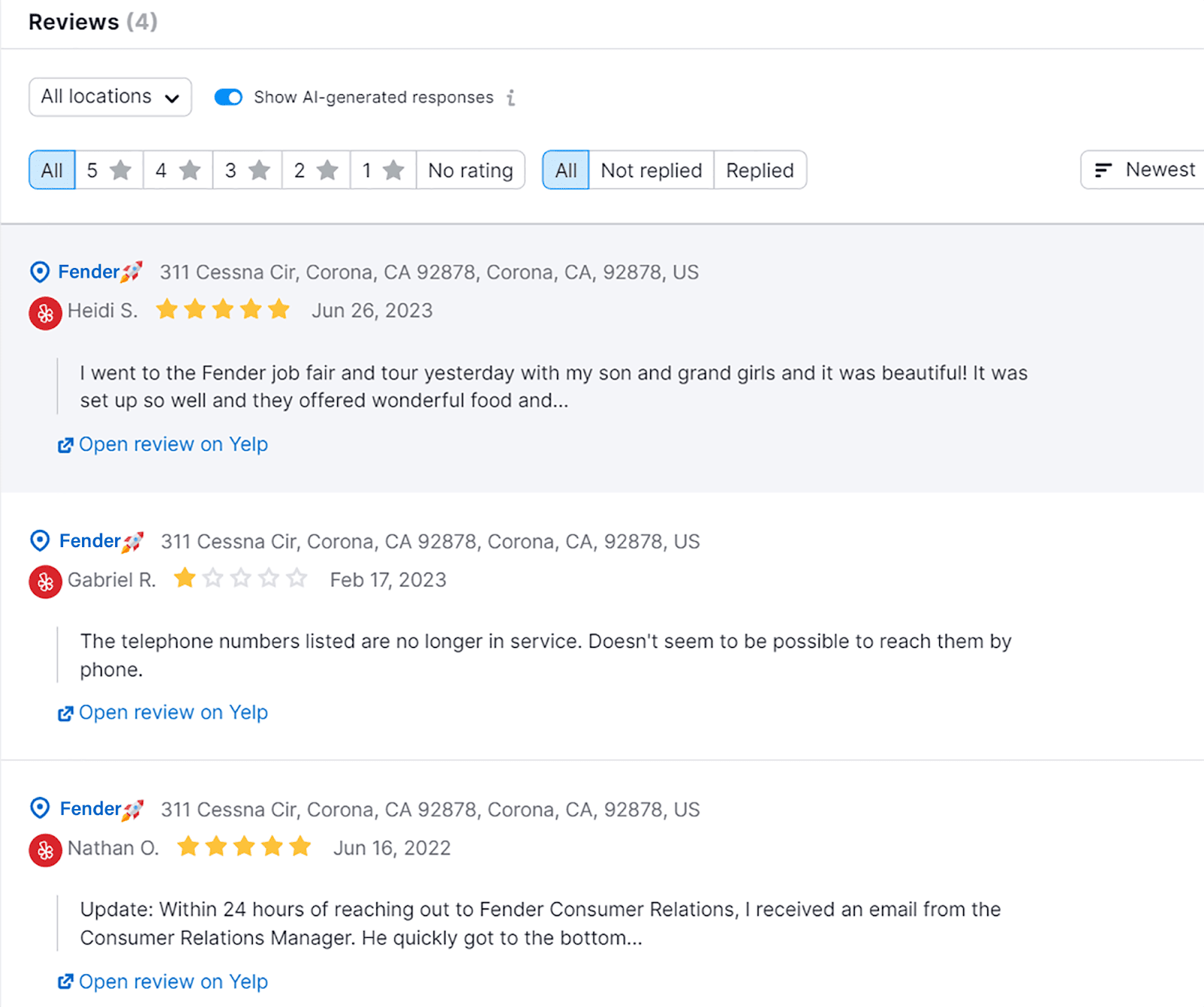
This then allows you to respond to your reviews and enhance your trustworthiness. I REALLY like this handy feature!
FAQs
Are there any specific industries or niches where E-E-A-T is particularly crucial for SEO?
While E-E-A-T is important for all content types, it’s crucial for YMYL topics. As discussed earlier, these are pages that could have serious implications on people’s health and finances if the information provided is inaccurate.
Some examples of YMYL niches include:
- Finance: content dealing with banking, taxes, investing, etc.
- Health and Safety: content about drugs, medical issues, hospitals, etc.
- News and current events: content dealing with news about international events, science, politics, natural disasters, etc.
- Civics, Government, and Law: content informing people about legal issues, voting, social services, etc.
- Shopping: pages where people can make online purchases
For YMYL topics, it’s absolutely vital that you follow E-E-A-T principles. Users need to be able to trust the information you provide and you need to minimize the risk of causing harm to users.
Are there any specific tools available to assess a website’s E-E-A-T level?
I’m afraid not. As I mentioned, E-E-A-T isn’t a single, measurable ranking factor. The best way to check that your pages are sending out E-E-A-T signals is to familiarize yourself with Google’s Quality Rater Guidelines and then stick to them.
What are the most common E-E-A-T mistakes?
The most common mistakes webmasters make when it comes to E-E-A-T include:
- Misrepresenting expertise
- Publishing poor-quality content
- Not including authoritative backlinks
- Not including references or citations
- Failing to provide clear contact info
- Not updating their content regularly
- Making exaggerated claims
- Publishing click-bait content
- Failing to secure the site with an SSL certificate
- Duplicating content
- Ignoring reviews

